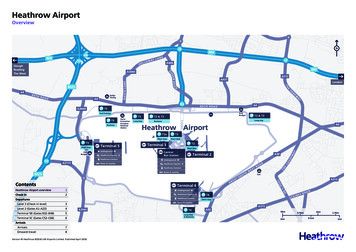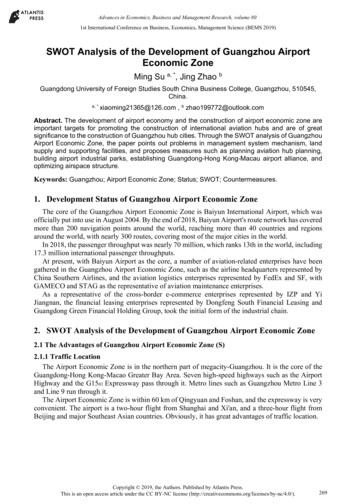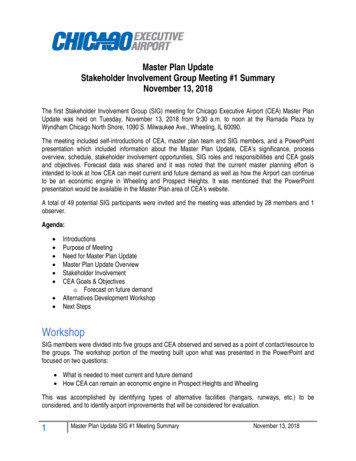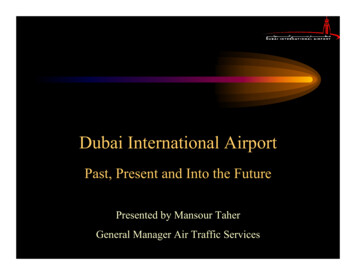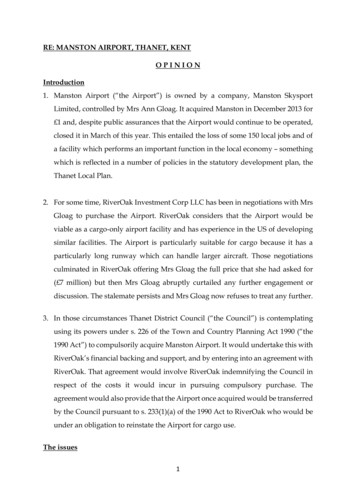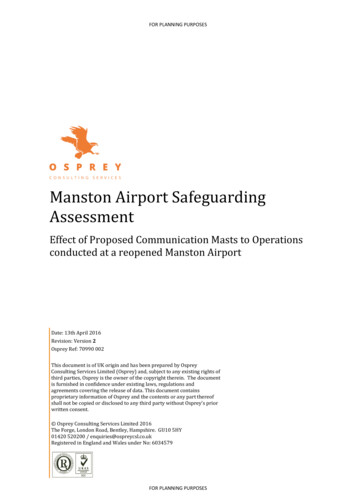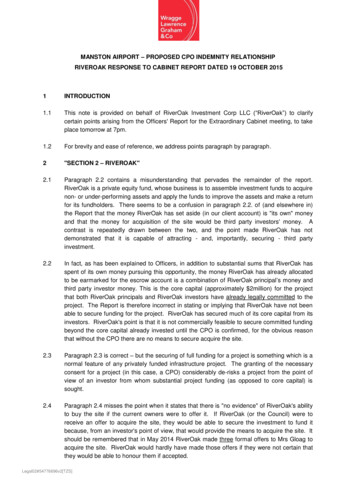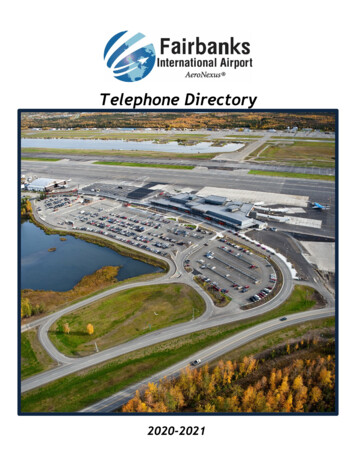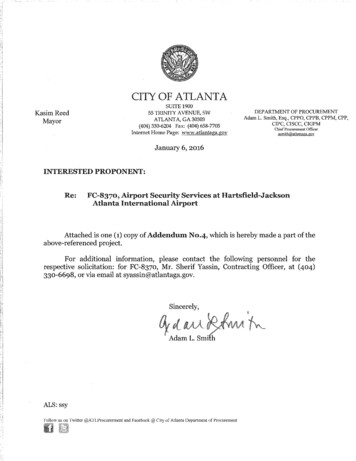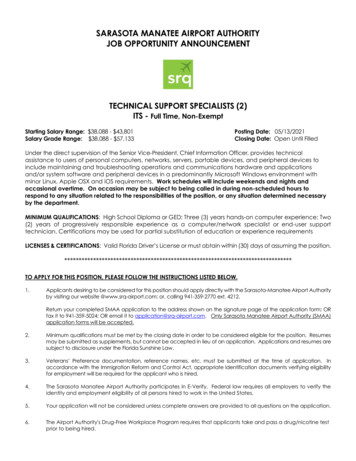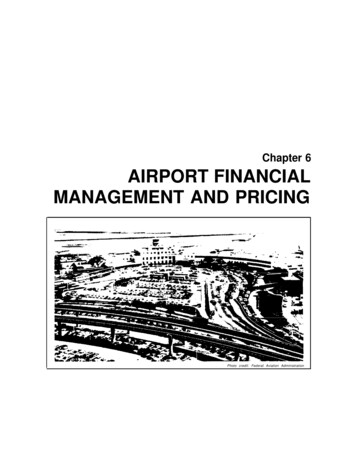
Transcription
Chapter 6AIRPORT FINANCIALMANAGEMENT AND PRICINGPhoto credit: Federal Aviation Administration
ContentsPageApproaches to Financial Management . . . . . . . . . . . . . . . . . . . . . . . . . . . . . . . . . . , . 125The Residual-Cost Approach . . . . . . . . . . . . . . . . . . . . . . . . . . . . . . . . . . . . . . . . . . 125The Compensatory Approach . . . . . . . . . . . . . . . . . . . . . . . . . . . . . . . . . . . . . . . . . 126Comparison of Residual-Cost and Compensatory Approaches . . . . . . . . . . . . . 127Pricing of Airport Facilities and Services . . . . . . . . . . . . . . . . . . . . . . . . . . . . . . . . 129Structure and Control of Airport Charges. . . . . . . . . . . . . . . . . . . . . . . . . . . . . . . 131Variation in the Source of Operating Revenues . . . . . . . . . . . . . . . . . . . . . . . . . . 133Trends in Airport Management Since Deregulation . . . . . . . . . . . . . . . . . . . . . . . . . 135Shorter Term Contracts. . . . . . . . . . . . . . . . . . . . . . . . . . . . . . . . . . . . . . . . . . . . . . . 135Modifications of Residual-Cost Approach . . . . . . . . . . . . . . . . . . . . . . . . . . . . . . . 136Maximization of Revenues . . . . . . . . . . . . . . . . . . . . . . . . . . . . . . . . . . . . . . . . . . . . 136List of TablesTable No.Page18. Financial Management of Commercial Airports, 1983 . . . . . . . . . . . . . . . . . . . 12619. Comparison of Residual-Cost and Compensatory Methods ofCalculating Airport Fees . . . . . . . . . . . . . . . . . . . . . . . . . . . . . . . . . . . . . . . . . . . . . 12720. Role of Airlines in Approving Capital Projects atCommercial Airports, 1983 . . . . . . . . . . . . . . . . . . . . . . . . . . . . . . . . . . . . . . . . . . 12821. Term of Airport Use Agreements at Commercial Airports, 1983 . . . . . . . . . . 13022. Profile of Landing Fees at Four Major Airports, 1982 . . . . . . . . . . . . . . . . . . . 13223. Average Operating Revenue by Revenue Source, Commercial andGeneral Aviation Airports, 1975-76 . . . . . . . . . . . . . . . . . . . . . . . . . . . . . . . . . . . 134
Chapter 6AIRPORT FINANCIAL1MANAGEMENT AND PRICINGUnlike airports in other countries, many ofwhich are owned and run by national governments, U.S. commercial airports are typicallyowned and managed by local governments orother non-Federal public authorities. Although themanagement approach varies, major U.S. commercial airports function as mature enterprises,applying up-to-date techniques of financial management and administration. These publicly ownedand managed facilities are operated in conjunction with private industry-the commercial airlines, which are the airports’ link to their patrons.This peculiar public-private character distinguishesthe financial operation of commercial airportsfrom that of wholly public or private enterprises,distinctly shaping airport management practices,the pricing of facilities and services, and the investment planning process.On the basis of a survey conducted by the Congressional Budget Office (CBO) in 1983 (app. B),this chapter develops a profile of financial policies and practices now followed at 60 of the Nation’s larger commercial airports and assessestrends in airport financial management since Federal deregulation of the airline industry in 1978.Brief attention is also given to management andfinancing practices of smaller airports, includingpublicly owned general aviation (GA) airports.APPROACHES TO FINANCIAL MANAGEMENTAt most commercial airports, the financial andoperational relationship between the airport operator and the airlines is defined in legally bindingagreements that specify how the risks and responsibilities of running the airport are to be shared.These contracts, commonly termed “airport useagreements, ” establish the terms and conditionsgoverning the airlines’ use of the airport.2 Theyalso specify the methods for calculating rates airlines must pay for use of airport facilities and services; and they identify the airlines’ rights andprivileges, sometimes including the right to approve or disapprove any major proposed airportcapital development projects.Although financial management practices differ greatly among commercial airports, the air——IThis chapter was prepared by the Congressional Budget Officeand appears in unabridged form in Financing U.S. Airports in the1980s, April 1984. The version here has been condensed and editedto conform to the OTA report format.“’Airport use agreement” is used generically hereto include bothlegal contracts for the airlines’ use of airfield facilities and leasesfor use of terminal facilities. At many airports, both are combinedin a single document. A few commercial airports do not negotiateairport use agreements with the airlines, but instead charge ratesand fees set by local ordinance.port-airline relationship at major airports typicallytakes one of two very different forms, with important implications for airport pricing and investment:The residual-cost approach, under which theairlines collectively assume significant financial risk by agreeing to pay any costs of running the airport that are not allocated toother users or covered by nonairline sourcesof revenue.The compensatory approach, under whichthe airport operator assumes the major financial risk of running the airport and chargesthe airlines fees and rental rates set so as torecover the actual costs of the facilities andservices that they use.The Residual-Cost ApproachA majority of the Nation’s major commercialairports surveyed by CBO—14 out of 24 large airports and 21 of 36 medium airports—have someform of residual-cost approach to financial management (see box A and table 18). Under this approach, the airlines collectively assume significant125.
126 . Airport System DevelopmentTable 18.—Financial Management ofCommercial Airports, 1983ApproachMediumLargeNumber Percent Number PercentSOURCE: Congressional Budget Office, 1963 Survey.lustrate the basic approach (see table 19). Mostairports have a number of different cost centers,such as terminal buildings, the airfield, roads andgrounds, and the air freight area. At a residualcost airport, the total annual costs—includingadministration, maintenance, operations, anddebt service (including coverage) —could be calculated for each cost center, and offset by allnonairline revenues anticipated for that center.3The residual between costs and revenues wouldthen provide the basis for calculating the ratescharged the airlines for their use of facilities withinthe cost center. Any surplus revenues would becredited to the airlines and any deficit charged tothem in calculating airline landing fees or otherrates for the following year.4The Compensatory ApproachUnder a compensatory approach, the airportoperator assumes the financial risk of airport operation, and airlines pay rates and charges equal tothe costs of the facilities they use as determinedby cost accounting. In contrast to the situationat residual-cost airports, the airlines at a compensatory airport provide no guarantee that fees andfinancial risk. They agree to keep the airportfinancially self-sustaining by making up any deficit—the residual cost—remaining after the costsidentified for all airport users have been offset bynonairline sources of revenue (automobile parking and terminal concessions such as restaurants,newsstands, snack bars, and the like).Although applications of the residual-cost approach vary widely, a simplified example can il-3Debt service coverage is the requirement that the airport’s revenues, net of operating and maintenance expenses, be equal to aspecified percentage in excess of the annual debt service (principaland interest payments) for revenue bond issues. The coverage required is generally from 1.25 to 1.40 times debt service, thereby providing a substantial cushion that enhances the security of the bonds.This is discussed further in ch. 7.4Haro1d B. Kluckholn, “Security for Tax-Exempt Airport RevenueBonds,” summary of remarks presented at the New York Law JournalSeminar on Tax-exempt Financing for Airports, 1980.
Ch. 6—Airport Financial Management and Pricing . 127rents will suffice to allow the airport to meet itsannual operating and debt service requirements.A compensatory approach is currently in use at10 of the 24 large commercial airports and 15 ofthe 36 medium airports surveyed by CBO.Although individual airports have adoptedmany versions of the compensatory approach, thesimplified example set out in table 19 illustratesthe basics. First, for each cost center a calculation would be made of the total annual expenseof running the center, including administration,maintenance, operations, and debt service (withcoverage). The airlines’ shares of these costs wouldthen be based on the extent of their actual use offacilities within each cost center. The airlineswould not be charged for the costs of public space,such as terminal lobbies. Nor would they receiveany credit for nonairline revenues, which offsetexpenses in the residual-cost approach but are disregarded under a compensatory approach in calculating rates and charges to the airlines.Comparison of Residual-Cost andCompensatory ApproachesThese two major approaches to financial management of major commercial airports have sig-nificantly different implications for pricing andinvestment practices. In particular, they help determine: an airport’s potentiaI for accumulating retained earnings usable for capital development;the nature and extent of the airlines’ role inmaking airport capital investment decisions,which may be formally defined in majorityin-interest clauses included in airport useagreements with the airlines; andthe length of term of the use agreement between the airlines and the airport operator.These differences, examined below, can havean important bearing on an airport’s performancein the municipal bond market, as will be discussedin chapter 7.Retention of EarningsAlthough large and medium commercial airports generally must rely on the issuance of debtto finance major capital development projects, theavailability of substantial revenues generated inexcess of costs can strengthen the performance ofan airport in the municipal bond market. It canalso provide an alternative to issuing debt for the
128Airport System Developmentfinancing of some portion of capital development.Residual-cost financing guarantees that an airportwill always break even —thereby assuring service without resort to supplemental local tax support—but it precludes the airport from generating earnings substantially in excess of costs. 5By contrast, an airport using a compensatoryapproach lacks the built-in security afforded bythe airlines’ guarantee that the airport will breakeven every year. The public operator undertakesthe risk that revenues generated by airport feesand charges may not be adequate to allow the airport to meet its annual operating costs and debtservice obligations. On the other hand, becausetotal revenues are not constrained to the amountneeded to break even, and because surplus revenues are not used to reduce airline rates andcharges, compensatory airports may earn and retain a substantial surplus, which can later be usedfor capital development. Since the pricing of airport concessions and consumer services need notbe limited to the recovery of actual costs, theextent of such retained earnings generally dependson the magnitude of the airport’s nonairlinerevenues. bBecause the residual-cost approach is not designed to yield substantial revenues in excess of. . -‘Peat, Marwick, Mitchell & Co., “Comparative Rate Analysis:Dade County Aviation and Seaport Departments, ” August 1982,p. 3.‘Market pricing of concessions and other nonairline sources ofrevenue is a feature of both residualcost and compensatory airports.costs, residual-cost airports, as a group, tend toretain considerably smaller percentages of theirgross revenues than do compensatory airports.A few residual-cost airports, however, have modified the approach to permit accumulation of sizable retained earnings for use in capital projects.At Miami and Reno International Airports, forexample, certain airport-generated revenues areexcluded from the revenue base used in calculating the residual cost payable by the airlines; therevenues flow instead into a discretionary fundthat can finance capital development projects.Majority in-interestIn exchange for the guarantee of solvency, airlines that are signatory to a residual-cost useagreement often exercise a significant measure ofcontrol over airport investment decisions andrelated pricing policy. These powers are embodiedin so-called majority-in-interest clauses, which area much more common feature of airport useagreements at residual-cost airports than at airports using a compensatory approach (see table20). At present, more than three-quarters of thelarge commercial airports using a residual cost approach have some form of majority-in-interestclause in their use agreements with the airlines,and two-thirds of the medium residual-cost airports have such clauses. Of the airports surveyed,only one-tenth of the large and one-third of medium commercial airports that use a compensatory approach to financial management havemajority-in-interest clauses in their use agreements.Table 20.—Role of Airlines in Approving Capitai Projects atCommercial Airports, 1983 Airline roleLargePercentNumberMediumNumberPercentResidual costMajority-in-Interest clause . . . . . . . . . . . . 11No formal requirement ofairline approval . . . . . . . . . . . . . . . . . . .3Total . . . . . . . . . . . . . . . . . . . . . . . . . . . . mpensatoryMajority-in-Interest clause . . . . . . . . . . . .1No formal requirement ofairline approval . . . . . . . . . . . . . . . . . . .9Total . . . . . . . . . . . . . . . . . . . . . . . . . . . . 10Grand total . . . . . . . . . . . . . . . . . . . . . 24
Ch. 6—Ai
eral deregulation of the airline industry in 1978. Brief attention is also given to management and financing practices of smaller airports, including publicly owned general aviation (GA) airports. APPROACHES TO FINANCIAL MANAGEMENT At most commercial airports, the financial and operational relationship between the airport oper-ator and the airlines is defined in legally binding
